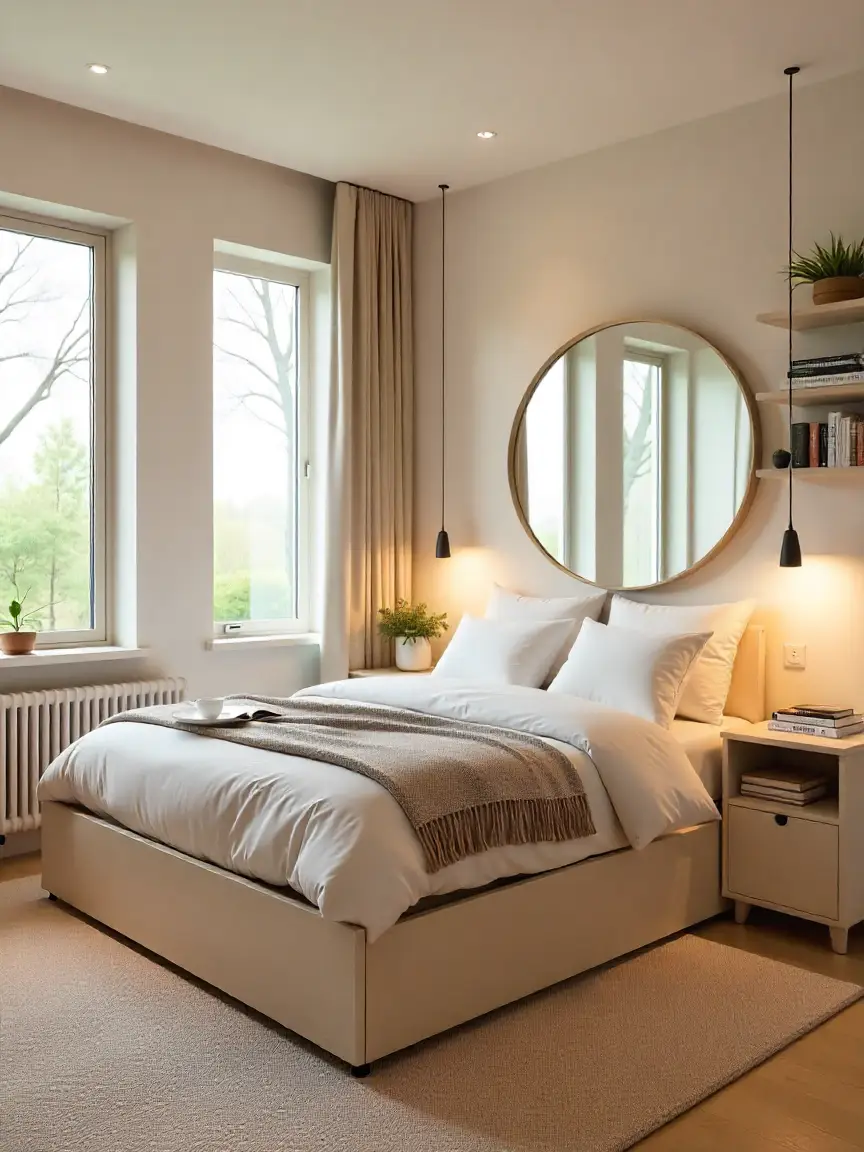Decorating a small bedroom can feel like a puzzle—every inch matters, and yet you still want the room to feel inviting, stylish, and clutter-free. Over the years as a decorator, I’ve seen many homeowners frustrated with the lack of space, believing they have to compromise comfort or beauty. But the truth is, with a few thoughtful hacks, even the smallest bedroom can feel spacious, functional, and inspiring.
The key is not just in what you add, but how you arrange, choose, and adapt pieces that work harder for you. Small bedrooms demand creative solutions that maximize every corner while still maintaining a sense of calm. In this article, I’ll share five of my favorite space-saving hacks that I’ve used time and time again with clients. These ideas go beyond simple storage—they’ll help you reimagine your bedroom into a space that feels both organized and stylish.
Whether you’re decorating your first apartment, downsizing, or simply working with limited square footage, these hacks will provide practical inspiration you can apply immediately.
Why Space-Saving Hacks Matter for Small Bedrooms
When dealing with compact bedrooms, the most common mistake I see is filling the space with bulky furniture and decor that quickly overwhelm the room. A bed that’s too large, side tables that are purely decorative, or storage solutions that don’t actually solve the problem—these choices only make the room feel tighter.
Space-saving hacks matter because they focus on efficiency and intentional design. They allow you to create balance between functionality and style. Instead of thinking, “I don’t have enough space,” the goal is to shift to, “How can I make the space I do have work harder for me?” That mindset alone changes the entire approach.
Another benefit is the way these hacks support a more minimalist lifestyle. A small bedroom doesn’t have to feel cluttered or chaotic. By using clever tricks like multi-functional furniture and vertical storage, you can design a room that feels airy, open, and restful. The bonus? Less clutter often means less stress, and a small bedroom can become a cozy retreat rather than a cramped corner of the house.
In today’s world where apartments are shrinking and homeowners want to make the most of every square foot, space-saving hacks aren’t just practical—they’re essential. They help transform small bedrooms into spaces that look polished while working seamlessly for everyday living.
Hack 1: Multi-Functional Furniture That Doubles Up on Purpose
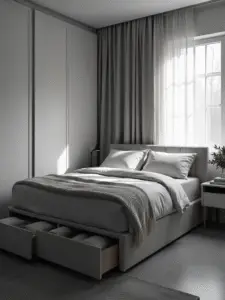
If there’s one golden rule for small bedrooms, it’s this: every piece of furniture should serve more than one purpose. Multi-functional furniture is not only practical, but it also keeps the room looking intentional rather than cluttered.
One of the best examples is a bed with built-in storage. Drawers beneath the mattress or lift-up frames provide a home for extra bedding, seasonal clothing, or even books. Instead of taking up additional closet space, everything tucks neatly under the bed, keeping the room streamlined.
Nightstands with drawers or open shelving are another game-changer. Instead of choosing a decorative table that only holds a lamp, opt for a small chest of drawers or a floating wall-mounted shelf. These choices save valuable floor space while still providing storage for everyday items like reading glasses, journals, or charging devices.
Another favorite of mine is a vanity or desk that doubles as a workspace. Many people think they don’t have room for both, but a well-chosen compact desk with drawers can function beautifully for getting ready in the morning and working during the day. Paired with a stylish chair that can be tucked in when not in use, it makes the room multifunctional without feeling crowded.
When shopping for new furniture, I always encourage clients to ask: Does this piece serve more than one role? If the answer is no, it’s worth reconsidering. In a small bedroom, multifunctional pieces are not optional—they’re essential.
Hack 2: Smart Vertical Storage to Maximize Wall Space
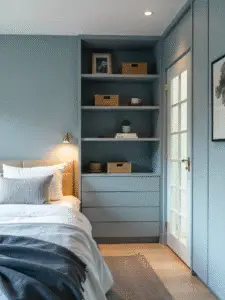
Floor space is often the first thing that feels limited in a small bedroom, which is why going vertical is one of the smartest hacks you can apply. Walls are often underutilized, yet they can transform the way your bedroom functions.
Start with shelving. Floating shelves or narrow bookcases can provide storage for books, decorative pieces, or even folded clothing. The key is to keep them visually light so they don’t overwhelm the space. I often recommend going for open shelving paired with baskets, which creates a balance between storage and style.
Another vertical solution I swear by is wall-mounted lighting. Instead of traditional table lamps that take up precious nightstand space, wall sconces or pendant lights free up surface areas while adding a modern design element. This instantly makes the room feel more open and less cluttered.
Closet space can also benefit from vertical thinking. Many closets only use the lower half efficiently, leaving wasted space above. Adding extra shelving or adjustable hanging rods helps maximize this area. Even outside the closet, a tall wardrobe with slim lines can replace bulky dressers, offering more storage without eating into valuable floor area.
Finally, don’t forget the back of the door. Over-the-door hooks or slim organizers are perfect for bags, scarves, or shoes. These hidden storage opportunities can make a surprising difference without adding any extra furniture.
When designed well, vertical storage not only saves space but also draws the eye upward, making the room feel taller and more spacious. It’s a simple yet powerful way to open up a small bedroom without expanding its footprint.
Hack 3: Under-Bed Solutions for Hidden Storage
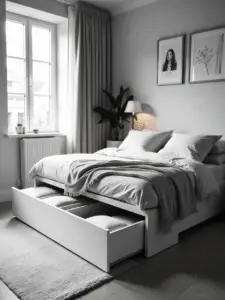
When working with small bedrooms, one of the most overlooked spaces is right beneath the bed. This area often collects dust or goes unused, yet it offers some of the most practical storage opportunities. With the right solutions, it can free up entire drawers and closets while keeping your belongings hidden from view.
Rolling storage bins are a simple yet effective option. They’re perfect for items like shoes, off-season clothing, or linens that you don’t need to access every day. If you prefer a cleaner look, go for storage bags with zip closures—they slide neatly under the frame and protect your belongings from dust.
For those planning to invest in new furniture, I often recommend a platform bed with built-in drawers. This eliminates the need for bulky dressers, which can crowd a small room, and instead creates a seamless storage solution that feels intentional. Even beds with hydraulic lift-up bases provide a large, hidden compartment beneath the mattress—ideal for bigger items like duvets, blankets, or suitcases.
The beauty of under-bed storage is that it keeps clutter out of sight while allowing your bedroom to remain open and airy. It’s one of the most effective hacks for small bedrooms because it doesn’t require additional furniture—just smarter use of what’s already there.
Hack 4: Creative Closet & Wardrobe Organizing Tricks
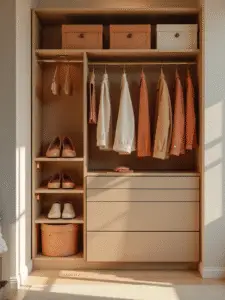
A small bedroom often means a small closet, but that doesn’t mean you’re stuck with limited storage. With a few clever organizing tricks, you can transform even the tiniest closet into a surprisingly efficient system.
One of my favorite strategies is using slim, non-slip hangers. They instantly double the amount of space compared to bulky wooden or plastic hangers, and they keep clothes from sliding off. Adding an extra hanging rod can also make a big difference, especially for shorter clothing items like shirts, skirts, and folded pants.
If your closet has unused vertical space, add stackable shelves or hanging organizers. These are perfect for shoes, handbags, or folded sweaters. Drawer inserts or small storage cubes can also create order within a larger shelf, preventing piles from becoming messy.
For wardrobes or freestanding closets, sliding doors are a space-saver compared to swinging doors that need clearance. And if your bedroom doesn’t have a built-in closet, a tall, narrow armoire with well-planned shelving can serve the same purpose without overwhelming the room.
Even something as simple as color-coordinating your wardrobe or grouping items by category can make a closet feel more intentional and less chaotic. A small change in organization often has a big impact on how spacious your bedroom feels overall.
Hack 5: Minimalist Layouts That Create More Room to Breathe
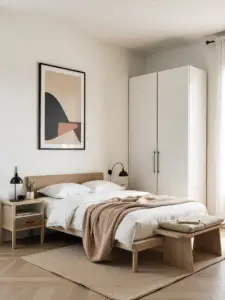
Sometimes, the key to saving space in a small bedroom is not about adding storage but about rethinking the layout. The way furniture is placed has a direct impact on how open or cramped a room feels.
Start with the bed—it’s the largest piece in the room, so its placement matters most. I often suggest positioning the bed against one wall, rather than floating it in the center, to free up walking space. In some cases, placing the bed in a corner can also open up floor area, though this works best for single sleepers.
Nightstands, dressers, and desks should be chosen based on proportion. Oversized furniture makes a small room feel even smaller, while slim, streamlined pieces create breathing room. Think narrow bedside tables, compact desks, and tall rather than wide storage pieces.
A minimalist layout also means editing what you bring into the room. Too many decorative accents can quickly overwhelm a small space. Instead, choose a few statement pieces—like a large piece of wall art or a beautiful headboard—that make an impact without cluttering every surface.
By simplifying the layout and being selective with furniture and decor, you allow the bedroom to feel larger than its square footage suggests. The result is a room that feels restful and balanced, rather than crowded.
Bonus Inspiration: Small Decor Touches That Make a Big Impact
Even in small bedrooms, decor plays an essential role in creating atmosphere. While storage and layout are practical concerns, the right decorative choices can make your space feel inspiring rather than purely functional.
One simple trick is using mirrors. A large wall mirror or mirrored wardrobe doors reflect light and create the illusion of depth, making the room appear larger. Soft, light-colored curtains also help the space feel airy and open.
Textiles add comfort without taking up space. Layering cozy bedding, throws, and cushions makes the room feel inviting, while a small area rug can define the space and add warmth.
Wall art and plants are also powerful tools. A vertical gallery wall or a hanging plant can draw the eye upward, emphasizing height rather than width. Even small accents like stylish baskets, trays, or decorative lighting can elevate the space without adding clutter.
It’s these small, thoughtful touches that turn a small bedroom from simply functional to truly inspiring.
Styling Tips to Keep Small Bedrooms Cozy Yet Spacious
Through my work, I’ve noticed that homeowners often struggle with balancing coziness and spaciousness. A small bedroom can feel cold if it’s too minimal or suffocating if it’s over-decorated. The secret is finding that perfect middle ground.
Here are a few styling tips I recommend:
-
Stick to a light color palette for walls and larger furniture, then add pops of color through decor.
-
Choose furniture with exposed legs—it allows light to flow under the piece, creating the illusion of more space.
-
Incorporate layered lighting. A mix of ceiling lights, wall sconces, and small lamps creates warmth without relying on just one harsh source.
-
Keep surfaces as clutter-free as possible. Decorative trays or baskets help corral small items neatly.
These small adjustments keep the bedroom cozy but prevent it from feeling overcrowded.
Common Mistakes to Avoid When Decorating a Small Bedroom
Over the years, I’ve seen certain decorating mistakes repeated often in small bedrooms. Recognizing them can help you avoid frustration and wasted space.
-
Choosing a bed that’s too large for the room, leaving no space for movement.
-
Filling the room with multiple small storage pieces instead of investing in a few multifunctional solutions.
-
Ignoring vertical space and relying only on floor storage.
-
Over-decorating with too many accessories, making the room feel cramped.
-
Poor lighting choices that make the room appear darker and smaller than it is.
Avoiding these mistakes ensures your space-saving hacks actually work, rather than being overshadowed by poor design decisions.
Conclusion & Final Inspiration
Small bedrooms can be a challenge, but they also present a wonderful opportunity to get creative. With the right space-saving hacks, you don’t have to compromise on comfort, style, or functionality. By choosing multifunctional furniture, embracing vertical storage, making the most of under-bed and closet spaces, and carefully planning layouts, your small bedroom can transform into a stylish retreat that feels larger than it is.
I always remind clients that a small bedroom doesn’t have to feel limiting. Instead, think of it as a chance to design more intentionally. With these five hacks and a few thoughtful touches, you’ll find inspiration to turn even the coziest room into a space that’s both functional and beautiful.

